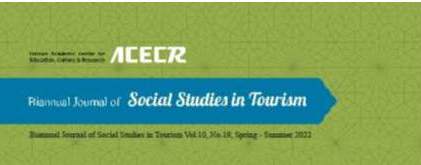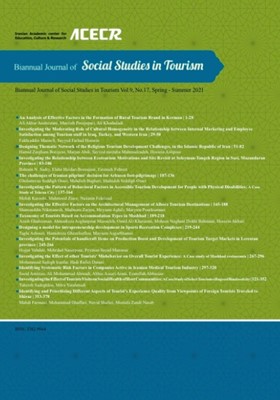-
-
List of Articles
-
Open Access Article
1 - An Analysis of Effective Factors in the Formation of Rural Tourism Brand in Kerman
Aliakbar Anabestani Marziyeh Pourjopari Ali Khodadadi -
Open Access Article
2 - Investigating the Moderating Role of Cultural Homogeneity in the Relationship between Internal Marketing and Employee Satisfaction among Tourism staff in Iraq, Turkey, and Western Iran,
Fakhrodin Maroofi Seyed Farhad Hosseini -
Open Access Article
3 - Tourism, Tourism development# Religious development#Systematic approach#Interpretive structural modeling (ISM)
Hamid Zargham Boroojeni marjan abdi Seyed Mojtaba Mahmoudzadeh hossein aslipour -
Open Access Article
4 - Investigating the Relationship between Ecotourism Motivations and Site Revisit at Soleyman-Tangeh Region in Sari, Mazandaran Province
Bahram Nekouie Sadry Elahe Heidari Boroujeni FATEMEH FEHREST -
Open Access Article
5 - The challenges of Iranian pilgrims' decision for Arbaeen foot-pilgrimage
Gholamreza Seddigh Oraei mahdieh bagheri Shahide Seddigh Oraei -
Open Access Article
6 - Investigating the Pattern of Behavioral Factors in Accessible Tourism Development for People with Physical Disabilities: A Case Study of Tehran City
mehdi karoubi Mahmood Ziaee Nazanin Fekrizad -
Open Access Article
7 - Investigating the Effective Factors on the Architectural Management of Alborz Tourism Destinations
Shamsodin Nikmanesh shabnam zarjou meysam Agheli maryam pour kasmaei -
Open Access Article
8 - Taxonomy of Tourists Based on Accommodation Types in Mashhad
Arash Ghahreman Ahmadreza AsgharpourMasouleh omid Ali kharzmi Mohsen Noghani Dokht Bahmani hosein Akbari -
Open Access Article
9 - Designing a model for intrapreneurship development in Sports Recreation Complexes
Taghi Ashouri hamidreza ghezelsefloo meysam asgarshamsi -
Open Access Article
10 - Investigating the Potentials of handicraft Items on Production Boost and Development of Tourism Target Markets in Lorestan province
Hojjat Vahdati mehrdad naserpoor peyman sayadmansoor -
Open Access Article
11 - Investigating the Effect of other Tourists' Misbehavior on Overall Tourist Experience: A Case study of Mashhad restaurants
Mohammad Sadegh Iranfar Hadi Rafiei Darani -
Open Access Article
12 - Identifying Systematic Risk Factors in Companies Active in Iranian Medical Tourism Industry[1]
Saeid Amirian Ali Mohammad Ahmadi Abbas Assari Arani Ezatollah Abbasian -
Open Access Article
13 - Investigating the Effect of Tourists Visits on Social Health of Host Communities: A Case Study of Select Tourism villages of Binalood city
tahereh Sadeghloo mitra yarahmadi -
Open Access Article
14 - Identifying and Prioritizing Different Aspects of Tourist's Experience Quality from Viewpoints of Foreign Tourists Traveled to Shiraz
mahdi farmani Mohammad ghaffari Navid Shafiei mostafa zandinasab
-
The rights to this website are owned by the Raimag Press Management System.
Copyright © 2017-2025







